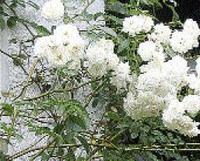

Roses are prone to rust.
Roses are prone to a fungal disease called rust. The diagnosis is easy as the disease causes red-orange spots on the undersides of leaves and yellow blotches on the top. This air-borne disease spreads quickly. Therefore, remove all infected leaves from the plant and the ground around the roses. You can also spray the plant with a commercial fungicide.
Good sanitation is the best cure.
Also, bear in mind that removing spent blooms and cutting roses for indoor arrangements encourages re-blooming. This is especially true of hybrid teas and floribundas. Cut the stems 1/4 inch above a five-leaf cluster at a 45-degree angle.
Bushy and blooming annuals
As the season progresses, annuals can become leggy and bear fewer flowers. Here are some tips to keep your plants in top condition.
Weeds compete with flowers for light, moisture and soil nutrients. Frequent weeding not only reduces the competition, but also breaks up the soil so water can penetrate more easily. A layer of mulch will help keep the weeds at bay.
Pinching out the tops of your plants helps to make them bushier. Most annuals grown today are bred for bushy growth, but older varieties and plants that have become leggy will benefit from having the tops pinched out.
Deadheading, or removing faded blooms, encourages the plant to put its energies towards making new flowers. If you plan to save seeds, wait until the end of the season, and allow the last of the flowers to go to seed.
Remove yellowing foliage to keep down diseases. If your plant becomes too dense, air may not be able to circulate well around the plant. This encourages diseases. To prevent such event thin the plant by removing some inner stems to improve air circulation and light penetration.
Toads: just love them!

Love that toad
The average toad will eat 50-100 insects every night - that's 10,000 to 20,000 insects throughout a gardening season. They will help eliminate garden pests such as flies, grubs, slugs, cutworms, grasshoppers, and anything else they are fast enough to catch.
You can encourage toads to take up residence in your garden by providing shelter and water, and by using gentle pesticides (or home-made ones) that won't hurt your warty allies.
Garden tools: how to choose them
In my opinion (and I am entitled to it!), one of the first thing to look for is comfort. You're going to be spending a lot of time with these tools, so you need to make 'play' a bit with a new tool before buying it. How about its weight? How does it feel in your hand? If it is a long-handled tool like a rake or shovel, is the handle long enough for you or will you have to bend over too much? If it's a pruner or shears, do they fit your hand well? Try out ergonomic tools that are designed to take the strain off your body, too.
After you've got that all straightened out in your mind, look at the price. Often you get what you pay for. A cheap tool cannot be expected to last. Is the metal substantial or thin? Has it been tempered for strength? If the handle is wooden, is it solid, without cracks or flaws? Is the blade of the shovel simply held on with crimped metal or by rivets or screws? Does the manufacturer or retailer offer a warranty? Are there replacement parts available? These are the main questions to keep in mind while shopping for the ideal tool .

